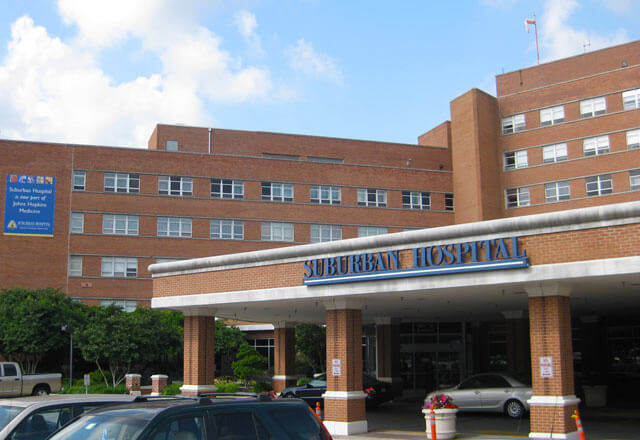


Brain Cancer
The Neuro-Oncology Program at the Johns Hopkins Kimmel Cancer Center in the National Capital Region includes specialists from neurosurgery, radiation oncology, medical oncology, nursing, pathology, imaging, pharmacy, and supportive services including pain management and oncology-trained patient and family staff. In addition to our clinical experts, our physician-scientists and laboratory researchers are exploring new ways to stop these complex cancers.
-
A brain tumor is a growth of abnormal cells in the brain. There are more than 120 different types of tumors that can develop in the brain, depending on what tissue they arise from.
-
Acoustic neuromas, also known as vestibular schwannomas, are noncancerous tumors that grow in the ear, and that can affect both hearing and balance.
-
Brain metastases occur when cancer cells spread (metastasize) from their original site to the brain. The types most likely to cause brain metastases are lung, breast, colon, kidney and melanoma.
-
Craniopharyngiomas are benign tumors that grow near the pituitary gland. They can develop as solid tumors or cysts (hollow sacs filled with fluid).
-
Glioma is a common type of tumor originating in the brain. About 33 percent of all brain tumors are gliomas. Treatment for a glioma is customized to the individual patient and may include surgery, radiation therapy, chemotherapy or observation.
- Astrocytoma
Astrocytomas are a growth of cells that start in the brain and looks similar to healthy brain cells. These are called glial cells and are among the most common primary brain tumor, accounting for nearly half of all primary brain tumors.
- Glioblastoma
Glioblastoma is a type of glioma and is the most aggressive and challenging type of brain cancer. It is a malignant brain tumor that grows and spreads very quickly.
- Astrocytoma
-
Meningioma is among the most common type of primary brain tumor. Meningiomas grow out of the middle layer of the meninges called the arachnoid. They grow slowly and may exist for years before being detected.
-
Neuroblastoma is a common solid tumor in the adrenal gland. In addition to brain tumors, it is common in children. The great majority of cases affect young children before school age, with some cases beginning before birth and unusual cases first arising as late as adolescence.
-
Pituitary tumors are usually benign. Pituitary cancers include pituitary carcinoma and systemic metastases to the pituitary gland.
-
Skull base tumors most often grow inside the skull but occasionally form on the outside. They can originate in the skull base as a primary tumor or spread there from a cancer elsewhere in the body as a metastatic brain tumor.
-
Ependymoma is a very rare type of tumor that starts in the brain or spinal cord. It can happen in both children and adults. Studies have shown that people with a genetic disorder called neurofibromatosis type 2 (NF2) have a higher risk of developing an ependymoma.
Types of Treatment
-
Medical oncology is a type of medicine that focuses on the diagnosis, treatment, and prevention of cancer. Medical oncologists treat cancer using medication, including chemotherapy, immunotherapy, and targeted therapy.
-
Craniotomy is the temporary removal of a piece of skull to allow surgeons access to the brain Patients are kept sedated and comfortable — but awake — during surgery so doctors can ensure normal brain function is unaffected.
-
Clinical trials are scientific studies in which new treatments are tested in patients to determine if they are safe and effective.
-
Photon therapy is a high energy form of radiation oncology that targets tumors with radiation. This highly effective treatment is often paired with surgery and/or medical oncology.
-
Proton therapy is the most advanced form of radiation oncology. High doses of radiation are delivered with pinpoint accuracy. Because the radiation does not “exit” the tumor, vital organs such as the brain, lungs, heart and spine, are spared the side effects from radiation.
Brain Tumor Diagnosis
Proper diagnosis is essential in determining the best course of treatment. Doctors use a variety of diagnostic tools, depending on the location of the tumor.
- A neurological exam with neurocognitive assessment
- A variety of imaging techniques, including CT (or CAT) scan, MRI,
- Biopsy (if possible)
- EEG
- Lumbar puncture
- Neuro-ophthalmological examination to assess for signs of tumor affecting the eyes.
- Endocrinological evaluation to assess hormone function.
Treatments
Johns Hopkins multidisciplinary clinic at Sibley brings together our brain cancer experts, who meet with each patient to evaluate their specific needs and to develop an individualized treatment plan. Treatment options include:
- Neurosurgery, using the most advanced surgical approaches available.
- Medical oncology, including chemotherapy, targeted therapy, immunotherapy and enrollment in clinical trials.
- Radiation oncology, including proton therapy in one of the most advanced centers in the country.
- Family and patient support services
- Rehabilitation




